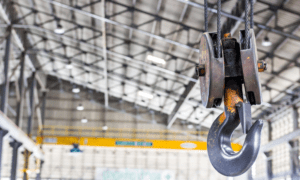 To perform a safe and successful lift, the crane operator and rigger(s) must consider the crane, environmental conditions, load, sling and hitch, and the desired operation. Since unbalanced loads, exceeding the crane’s capacity, or using a defective sling can quickly result in catastrophic results, this article will discuss each of the five components and their proper use and inspection.
To perform a safe and successful lift, the crane operator and rigger(s) must consider the crane, environmental conditions, load, sling and hitch, and the desired operation. Since unbalanced loads, exceeding the crane’s capacity, or using a defective sling can quickly result in catastrophic results, this article will discuss each of the five components and their proper use and inspection.
Crane Considerations
Determining crane capacity may seem straightforward since common sense should dictate that a 20-ton crane cannot safely move a 25-ton load. When calculating the total load, it is critical to include not only the load’s weight but also the weight of the rigging components, including:
- Slings
- Hardware
- Spreader bars
- C-hooks
- Magnets
- Lifting beams
Determine the center of gravity: the point at which the load will become balanced as the horizontal and vertical balance points intersect is the center of gravity (COG). The COG should be directly below the load hook, with the load connection point directly above the load’s center of gravity.
All non-essential employees should move to a designated safety area when a load gets lifted, moved, or lowered. Any essential workers near the lift area or travel path should maintain a clear line of sight or radio contact with the lift team during the operation. Every lift plan should be reviewed by a Qualified Person (as deemed by the employer or end-user) before the lifting or moving process begins to ensure compliance with all safety measures and applicable regulations.
Environmental Considerations
Unlike their indoor counterparts, local weather can impact outdoor crane operations significantly. While wind remains the most critical factor for outdoor cranes and their function, a thorough lift plan should also address the following environmental factors:
Chemically active work areas can damage most cranes and their components. Caustic chemicals can deteriorate metal surfaces, allowing rust and corrosion to establish a foothold. Petroleum-based products can damage seals, gaskets, and wiring looms, effectively shutting down any scheduled lift activities.
Extreme hot and cold temperatures can affect several crane components, including:
- Fluid viscosity of oil and hydraulic fluids.
- Metal expansion and contraction can affect tolerances, resulting in excessive free play or binding between components.
- Excessive moisture can damage fuel systems, switches, relays, and sensors.
- Snow and ice buildup creates additional safety hazards for the lift team and nearby workers.
For mobile cranes, elevation changes can affect fluid viscosity and flow rates and should be tested and addressed before attempting a lift.
Sling and Hitch Considerations
To properly support and connect the load for movement, the rigger must choose the best sling option available to maximize safety and control. ASME B30.9 (American Society of Mechanical Engineers) covers the fabrication, attachment, use, maintenance, testing and use standards for slings including:
- Synthetic rope slings
- Synthetic round slings
- Synthetic web slings
- Alloy chain slings
- Wire rope slings
- Metal mesh slings
The standards state that all slings must be inspected for damage, excessive wear, or other irregularities before each use.
Understanding how to rig a load begins with the type of load and determining the correct hitch. Here are five of the most used sling and hitch options used today.
Vertical Hitch (Straight Line Hitch): Ideal for easy-to-balance loads, this arrangement uses a single sling with one end connected to the load and the other attached to the hoist, crane, or lift mechanism.
Double Line Hitch: Works for larger loads by using two slings connected at one end to the lifting device and attached to the load at two locations.
Choker Hitch: Uses a single sling with one end attached to the lifting equipment and the other attached to the sling with a loop around the load.
Double-Wrap Choker Hitch: Provides 360° contact around the load while compressing the materials to minimize slippage during movement.
Basket Hitch: It also uses a single sling that passes around the load before both ends connect to the lift mechanism.
The choker and basket hitch can be used with a lifting beam to increase load stabilization for longer loads.
Sling Angles
Slings are designed to lift the load at a 90° angle to the floor or ground. As the lift angle decreases to 60°- 45°- 30°, so does the sling’s lift capacity. Always double check the rigging schedule to confirm the capacity for a specific angle.
Working Load Limits (WLL)
WLL refers to the maximum force or mass a product can support during a specific activity. Consequently, all the components used for the lift must be manufactured from the same materials with equal WLL ratings, including:
- Shackles
- Turnbuckles
- Chains
- Hook
Mismatching WLL product ratings can result in unsafe lifting conditions while increasing the potential for component failure, load damage, and physical harm to workers.
Sling Protection Considerations
Most sling damage, such as cuts, tears, or abrasions, is preventable by adding corner pads, sleeves, or guards to the lift process. These protection options protect the load from rough surfaces, corners, and other protrusions along the load’s travel path. Using edge protection helps maintain the sling’s integrity, which can prevent excessive wear or failure. For increased safety, consider adding protection devices on every edge of the load, not just the primary load surfaces.
If you have any questions about slings, including rigging equipment, lift-specific products, or rigging best practices, you can email the Hi-Speed Crane Experts or call us today at 800-713-0103.

